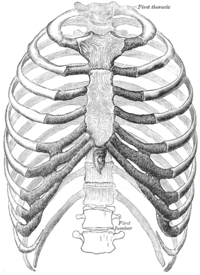
Photo from wikipedia
BACKGROUND This study aimed to evaluate the congenital anomalies of ribs in the Turkish population using multi-detector computed tomography (CT) and to reveal the prevalence and distribution of these anomalies… Click to show full abstract
BACKGROUND This study aimed to evaluate the congenital anomalies of ribs in the Turkish population using multi-detector computed tomography (CT) and to reveal the prevalence and distribution of these anomalies according to genders and directions. MATERIALS AND METHODS This study included 1120 individuals (592 male, 528 female) over 18 who applied to our hospital with a suspicion of Covid-19 and who had thoracic CT. Anomalies such as a bifid rib, cervical rib, fused rib, SRB anomaly, foramen rib, hypoplastic rib, absent rib, supernumerary rib, pectus carinatum, and pectus excavatum, which were previously defined in the literature, were examined. Descriptive statistics were performed with the distribution of anomalies. Comparisons were made between the genders and the directions. RESULTS A prevalence of 18.57% rib variation was observed. Women had 1.3 times more variation than men. Although there was a significant difference in the distribution of anomalies by gender (p=0.000), there was no difference in terms of anomaly direction (p>0.05). The most common anomaly was the hypoplastic rib, followed by the absence rib. While the incidence of the hypoplastic rib was close in women and men, 79.07% of the absence rib was seen in women (p<0.05). The study also includes a rare case of bilateral first rib foramen. At the same time, this study includes a rare case of rib spurs extending from the left 11th rib to the 11th intercostal space. CONCLUSIONS This study demonstrates detailed information about congenital rib anomalies in the Turkish population, which may vary between people. Knowing these anomalies is essential for anatomy, radiology, anthropology, and forensic sciences.
Journal Title: Folia morphologica
Year Published: 2023
Link to full text (if available)
Share on Social Media: Sign Up to like & get
recommendations!